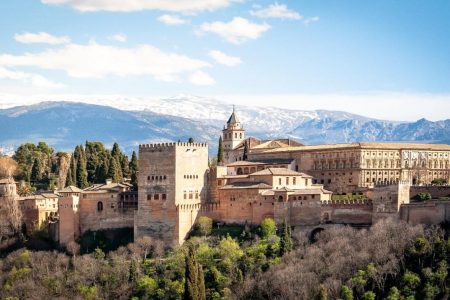The Islamic conquest of the Iberian Peninsula ushered in the Islamic Golden age to the European continent, encompassing the peninsula and beckoning an era of enlightenment and flourishment for many fields of study such as science, art, agriculture, mathematics, and medicine: Al-Andalus was a go-to hub for cultural and social exchange. It comes to no one’s surprise that Al-Andalus is remarkably known for its exquisite, unique, and detailed Moorish and Mudéjar architecture, scattered all-over Modern-day Spain and Portugal. The former was used from the 13th to 16th century and the latter was popularized from the 12th till the 16th century. To this day, The Iberian Peninsula remains to house those architectural treasure troves.
The word “Moor” is Latin for “Maurus” meaning “Dark-Skinned.” The term originally referred to the people of Mauritania, a region in modern-day northern Morocco and western-central Algeria. The Moors, who ruled Al-Andalus, for nearly 800 years, refers to multiple caliphates that ruled the peninsula such as the Umayyad Caliphate, the Caliphate of Córdoba, the Almoravids and the Almohad. They brought with them a style of building that was influenced by both the Islamic and Roman worlds. The result was a unique blend of arches, domes, columns, and intricate geometric patterns. They focused on building palaces, mosques, and places of worship that adhere to Islam.

One of the best-known examples of this architectural style is the Alhambra, a 14th-century fortress known for being one of the last major strongholds held by Islamic forces. It is located in Granada, a city known for its Moorish Architecture. The Alhambra is a testament to the Moor’s complex engineering skill, creativity, and profound understanding of mathematical and geometric concepts. It remains one of the most visited tourist attractions in Spain to this day and is a UNESCO world heritage site.
One of the main characteristics of Moorish Architecture is its exquisite detailing and elaborate ornamentation consisting of everything from Arabic calligraphy, geometrically complex shapes, and floral motifs to horseshoe arches. Moors forbade depictions of animals, humans, and plants and instead chose to depict patterns and shapes with intricate detailing. Such can be seen in the interior of the Alhambra below.

By the 13th century, Spanish Christian rulers began slowly taking the region back, beginning the Reconquista era, where Al-Andalus sought independence from Caliphate control. Spanish Catholic rulers would gradually push away the Moors and retake major cities. The Reconquista ended in a win for the Spanish Catholics, with the Moors exiting the continent in 1492, thus beginning a new architectural era for the peninsula.
The word “Mudéjar” (moo-DAY-har) roughly translates to “those who remained or stayed behind” and is derived from the Arabic “Mudajjan” meaning “tamed.” After the Moors were defeated, many left for North Africa. They were also allowed to stay without converting to Christianity. The Moors, however, became manual laborers for the Spanish rulers, who had them build churches and Christian houses of prayer. In fact, they often ordered the remaining Moors to tear down the mosques they built so they could be used as foundations for other buildings instead. Likewise, those same Christian rulers heavily influenced the building process which led to an organic yet the natural blend of both Islamic and Christian-inspired architecture. This resulted in the creation of an architectural style combining Christian, Romanesque, Gothic Renaissance, and Islamic influences. Originating in Toledo, Mudéjar architecture spread its influence to cities like Turuel, Aragon, and Seville, and eventually throughout the Iberian Peninsula, where sightseers will witness many Mudéjar-styled towers and palaces.
The most preserved Mudéjar styled architecture can be seen in the Casa de Pilatos in Seville. Combining both Renaissance and Mudéjar elements, the architectural style blended gothic and Islamic themes. They used bricks as the main building block. However, they did not create new shapes and structures, instead, they sought to reimagine Western architectural themes through major Islamic architectural motifs. The Casa de Pilatos exclusively uses rectangles as its main geometric shape as well as having large inner Patios decorated with renaissance-styled statues. The inner patio serves as a nod to Islamic architecture, as many used the fountain in the middle for washing up.
It goes without saying that Islamic architecture continued to play a dominant role in influencing Spanish and European architecture all throughout the Iberian Peninsula’s Middle Ages. Today, the legacy of Al-Andalus’ architecture can still be seen in the various intricate buildings and architectural works of art. Many of which are now considered UNESCO heritage sites. Whether you are an academic or a researcher, or simply just someone who is interested in history and culture, one cannot deny the presence of Islamic influence found although Al-Andalus.
IEREK is Proudly Organizing the 7th Edition of the International Conference “Cities’ Identity Through Architecture and Arts – CITAA” to be held in Collaborating with Université Sidi Mohammed ben Abdellah, Morocco from 26th September to 28th September 2023.
For Registration follow the conference website: https://www.ierek.com/events/cities-identity-through-architecture-and-arts-citaa-7th-edition
